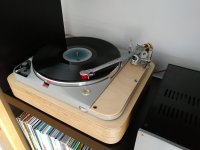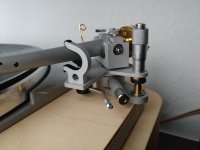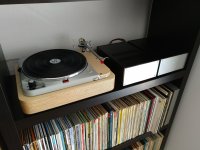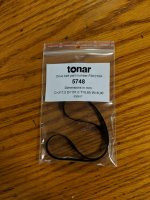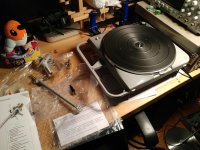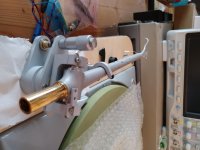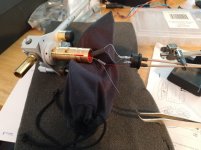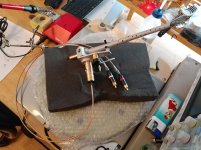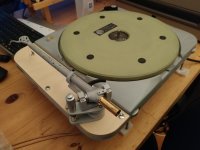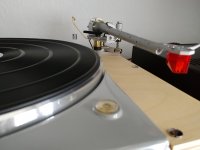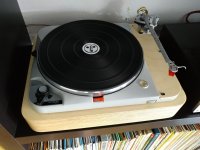Thanks guys. I have one fiber one that is cracked and one I misplaced. McMaster-Carr is lacking in the proper sizes which is unusual for them.
McMaster-Carr
To a page for the phenolic washers you seek.
Thorens used phenolic flat washers as a spacer to achieve correct idler wheel height relative to the stepped pulley. But for the actual thrust washer they used a transparent nylon washer. It would be easy to lose track of one of these.
Here's a photo of the idler wheel thrust -plus- phenolic spacer assembly in a project as it was found during disassembly:

Thanks for the great thread. It seems you've left no stone unturned. I am rebuilding my E-50 motor and notice the coils are quite loose in their housing. Does anyone know about shimming the coils so they are held tightly in the case? If so, what did you use as material? Nylon tie strap material seems about the right thickness but I'm sort of concerned with the heat.
I have noticed some coils that were loose within the casings...particularly on early units. I have no comments or suggestions as to what should be done with this. I am happy to defer to the other commenters that have more experience with electronics and also motor design. I have noticed that the motor coils as supplied by AudioSilente do fit snug within the housing. These are a somewhat thicker bundle and squeeze in rather than drop in as do the older coils.
re: those flat washers that go on top of the motor mount grommets. The factory used some sort of composition washer. Soft. Like a tough gasket material. Papery. I believe Schopper, in their mk2 conversion kit offer an interesting top washer replacement of similar construction to the original. I haven't seen these anywhere else. Perhaps by now there are.
-Steve
Hi,
I still have not tried to attempt the chassis bend yet. I have been busy and decided to work on the plinth and motor. I have a quick question. What have people used to clean the metal parts of the motor? Can I use Brasso? The shield between the motor and pulley is very dirty. I was going to drop the other parts in carb cleaner. m
I still have not tried to attempt the chassis bend yet. I have been busy and decided to work on the plinth and motor. I have a quick question. What have people used to clean the metal parts of the motor? Can I use Brasso? The shield between the motor and pulley is very dirty. I was going to drop the other parts in carb cleaner. m
Hi,
I still have not tried to attempt the chassis bend yet. I have been busy and decided to work on the plinth and motor. I have a quick question. What have people used to clean the metal parts of the motor? Can I use Brasso? The shield between the motor and pulley is very dirty. I was going to drop the other parts in carb cleaner. m
re: motor parts cleaning.
lacquer thinner with a rag.
carb cleaner soak for the case top, bottom and swivel parts that hold the bushings.
You can replace the oil retaining felts or just clean them with lacquer thinner and see if they look fresh again afterward.
New bushings?
-Steve
Hi,
I still have not tried to attempt the chassis bend yet.
Hello mbergerooo,
Before you bend the chassis, you may want to look at the tone arm board mounting surface above the bent area. If it is flat, don't bend the chassis!
The flatness of the tone arm board mounting surface takes precedence over bends in the chassis.
If the tone arm board mounting surface is flat, the chassis may have warped during the die casting process.
Use a 12" steel scale as a straight edge.
Sincerely,
Ralf
Hi Ralf,Hello mbergerooo,
Before you bend the chassis, you may want to look at the tone arm board mounting surface above the bent area. If it is flat, don't bend the chassis!
The flatness of the tone arm board mounting surface takes precedence over bends in the chassis.
If the tone arm board mounting surface is flat, the chassis may have warped during the die casting process.
Use a 12" steel scale as a straight edge.
Sincerely,
Ralf
I did measure down from a straight edge on the platter. The armboard casting may not be off by very much at all. I am waiting until a drop it into the CLD plinth I am building now. That will help me nail down exactly how much of a problem I may have.
I also have woodworking skills and may just shape my armboard to compensate for the casting issue. But only if it doesn't look terrible.
m
Hi Steve,re: motor parts cleaning.
lacquer thinner with a rag.
carb cleaner soak for the case top, bottom and swivel parts that hold the bushings.
You can replace the oil retaining felts or just clean them with lacquer thinner and see if they look fresh again afterward.
New bushings?
-Steve
I found the info on your site after posting. Thanks for all the information you post there. It is my most visited site on the internet. My TD160 was happier for it and now the TD124 will be as well.
I ordered new bushings from Audio-Silente.
m
Check it out, I finished my Audiomods Classic II Micrometer tonearm kit build today!
It sounds even better than it looks.
I recall using an Expressimo modded RB250 on my first TD124 to very good effect. I imagine one of the Audiomods arms would be considerably better soundwise, but also much more accommodating for vta/sra. The string and weight anti-skate seems like an entirely good idea.
Credit must go to Rega (Roy Gandy & crew) for creating this beautifully cast armtube. Such a casting will not be cheap to tool up for. Many thousands of dollars must be paid to the Tool & Die firm that produces the molds.
I wonder what Roy Gandy thinks about this implementation of his precious little brainchild!
-Steve
Hello mbergerooo,
Before you bend the chassis, you may want to look at the tone arm board mounting surface above the bent area. If it is flat, don't bend the chassis!
The flatness of the tone arm board mounting surface takes precedence over bends in the chassis.
If the tone arm board mounting surface is flat, the chassis may have warped during the die casting process.
Use a 12" steel scale as a straight edge.
Sincerely,
Ralf
Certainly extreme care is in order here. Also, some experience with castings helps. In recent years I worked as QC/CMM programmer at an investment casting operation just North of Seattle, Wa. This was late in my career and the first foundry I'd been in. What I found was that castings routinely require secondary operations (post cast) to correct flaws and imperfections in the castings made. One of these processes will involve straightening of parts that warp during the cool-off part of the cast process. And there are limits to what can be done.
One of the causes of part warp during cool-off is having a more massive part of the casting directly adjacent to a thinner portion of it. As the part cools off the more massive portion tends to pull against the thinner areas and then a warp occurs. And the armboard area of these early castings are quite obviously thinner than the rest of it.
My thought is that the foundry that produced these castings would have been very much aware of this and would have straightened all castings prior to shipment. However, it is possible that some product could have escaped inspection.
Just as likely these castings are light enough in the armboard area to become warped/bent through careless handling. Such as someone holding a bare casting by using the armboard area as a handle and perhaps putting too much load (force) on it.
If you compare directly the early casting to the revised later castings it is quite apparent that the later versions were very much reinforced in this critical area to prevent just such damage from happening. Apparently they (Thorens) learned through trial and error on this.
One thing that is of concern, when using a 9 inch tonearm, is azimuth. If the early casting has something like this:

Around 1/16th" pulled up at the edge, there will be some azimuth error in the tonearm mounting. While this can be compensated for at the headshell on many tonearms, the pivot bearings will still be angling downward rather than parallel to the platter as the arm tracks. Not so good.
Of course it is needed to check that the casting bed where the armboard mates is flat and not curved or irregular in surface over the entire area.
My experience so far is that they have been but there are hundreds of thousands of these chassis out there and no doubt we have yet to see what condition all of them are in.
Extreme care is on order and the supply of these 60 yr. old castings is finite. Let's not ruin any.
Link to more images of one of the warped chassis I worked on:2078 chassis
-Steve
Last edited:
On a positive note, I found a very quiet belt. I sourced it through these guys. Thorens TD124 Top Platter upgrade - Retrotone
I bought the top-platter from them and as an afterthought decided to see if they had belts. The sourced them from someone-obviously. Exceptionally quiet! I rebuilt the motor at the same time and it was about as noisy as it had been with the old belt on it. A few days later the new belts showed up and magically the table is now almost silent. With ones ear 2 inches away there is NO noise with all the platters spinning away.
I bought the top-platter from them and as an afterthought decided to see if they had belts. The sourced them from someone-obviously. Exceptionally quiet! I rebuilt the motor at the same time and it was about as noisy as it had been with the old belt on it. A few days later the new belts showed up and magically the table is now almost silent. With ones ear 2 inches away there is NO noise with all the platters spinning away.
Attachments
Interesting on the upper platter. Machined from solid stock (alu, we presume) and much heavier than the original part. Their ad suggests that this is intended for use on the TD124 that has the lighter Zamak platter. However I'm interested in it for the iron platter as well. I imagine the standard bearing can handle an extra couple of pounds just fine for this.
How did the upper platter fit? Same as the original?
Does it spin true?
Does the clutch lever lift this heavier upper platter? Does it require adjustment of clutch clearances? (I'd imagine it does)
Looks interesting. Oh, and good news about the belt Thanks for posting.
Thanks for posting.
-Steve
How did the upper platter fit? Same as the original?
Does it spin true?
Does the clutch lever lift this heavier upper platter? Does it require adjustment of clutch clearances? (I'd imagine it does)
Looks interesting. Oh, and good news about the belt
-Steve
The platter spins true although the spindle hole is slightly oversized so the top-plate can center itself over the lower platter. I did not have an original platter so I can't compare the two. The clutch seems to work fine. There is a minor scraping sound while the platter is lifted off the driven one. No adjustment was needed. The contact has nothing (I believe) to do with the height of the lift. I believe it is that the diameter of the reproduction is closer to the cast iron platter and if it is not centered exactly, the lower platter just "kisses the upper one as it rotates within. I do not have the lower platter bolted to the spindle yet and that may well fix the problem, minor as it is.
Still playing with it though. I'll keep you updated.
Still playing with it though. I'll keep you updated.
I recall using an Expressimo modded RB250 on my first TD124 to very good effect. I imagine one of the Audiomods arms would be considerably better soundwise, but also much more accommodating for vta/sra. The string and weight anti-skate seems like an entirely good idea.
Credit must go to Rega (Roy Gandy & crew) for creating this beautifully cast armtube. Such a casting will not be cheap to tool up for. Many thousands of dollars must be paid to the Tool & Die firm that produces the molds.
I wonder what Roy Gandy thinks about this implementation of his precious little brainchild!
-Steve
Roy hinted it cost £50 000 years ago just for the machine. The partner company shared the cost as the idea was unique. That is the mold is kept hot and full of metal, a solenoid ram is used to form the tube in less than 5 mS I seem to rememeber. Roy came from Ford so had no problem thinking that way. It is rumoured Lesney Matchbox helped. They were in the same industrial unit in the 1980's. Roy firmly refused to say when asked.
Roy told me he never made money from Rega. In fitting out the Rega factory he started doing the same for other industrial units and restoring houses. That made the money. Everyone I say that to laughs and says that's Roy, he enjoys saying it. Myself, I think it's true. As Herodotos said. "You can always tell when people are lying as they hesitate". Mr Gandy didn't. In the context Mr H said it he was such a modern thinker.
The audiomods tonearms are built around a modified Rega armtube, correct. If I'm not mistaken, all other parts except the tonearm lift are made by Jeff Spall, the man behind audiomods. He's a pleasure to deal with btw.
I figured the matte (sand blasted) finish would blend in nicely with the grey lacquer of the TD124. And together with the oiled birch multiplex plinth and armboard it turned out nice indeed, methinks. Sort of an understatement, pimped by the arm's bronze parts.
Putting together the arm kit was good fun, safe for the soldering of the tonearm wire, that was a bit fiddly.
I feel like the audiomods arm handles the TD124's pace and impact very well. I haven't spent that much time with it yet, but I believe I prefer it to my overhauled SME 3009 S2 improved (steel knife bearing) arm. It sounds less vintage and more in control.
I figured the matte (sand blasted) finish would blend in nicely with the grey lacquer of the TD124. And together with the oiled birch multiplex plinth and armboard it turned out nice indeed, methinks. Sort of an understatement, pimped by the arm's bronze parts.
Putting together the arm kit was good fun, safe for the soldering of the tonearm wire, that was a bit fiddly.
I feel like the audiomods arm handles the TD124's pace and impact very well. I haven't spent that much time with it yet, but I believe I prefer it to my overhauled SME 3009 S2 improved (steel knife bearing) arm. It sounds less vintage and more in control.
Attachments
It appears to a well made bit of kit, and I am sure it was a lot of fun to put together. I have little trouble accepting that it is superior in performance to a 3009 S2 Improved even with steel knife edge. I've had the misfortune of owning 4 of the S2 unimproved of various vintages (three simultaneously) and found it to be hopelessly out of date, it was just mediocre in terms of detail retrieval, overly polite, and uninvolving. The 3009 came close to ending my interest in vinyl. Despite the many common components and shared design the 3012 is much better.
The stock swiss cheese head shell is a huge liability IMO, replacing it with a Yamamoto, Ortofon, AT, Orsonic or other head shell results in an immediate improvement.
The stock swiss cheese head shell is a huge liability IMO, replacing it with a Yamamoto, Ortofon, AT, Orsonic or other head shell results in an immediate improvement.
Roy hinted it cost £50 000 years ago just for the machine. The partner company shared the cost as the idea was unique. That is the mold is kept hot and full of metal, a solenoid ram is used to form the tube in less than 5 mS I seem to rememeber. Roy came from Ford so had no problem thinking that way. It is rumoured Lesney Matchbox helped. They were in the same industrial unit in the 1980's. Roy firmly refused to say when asked.
Roy told me he never made money from Rega. In fitting out the Rega factory he started doing the same for other industrial units and restoring houses. That made the money. Everyone I say that to laughs and says that's Roy, he enjoys saying it. Myself, I think it's true. As Herodotos said. "You can always tell when people are lying as they hesitate". Mr Gandy didn't. In the context Mr H said it he was such a modern thinker.
Yes, true enough, but it's all Greek to me..
-Steve
- Home
- Source & Line
- Analogue Source
- Restoring and Improving A Thorens TD-124 MKII
